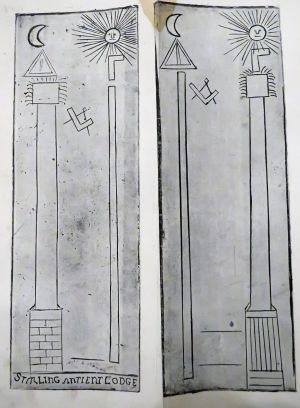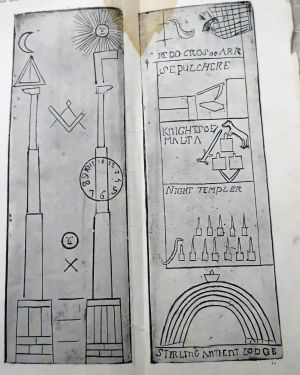En: Sterling ancient Brass Plates: Unterschied zwischen den Versionen
(Die Seite wurde neu angelegt: „== Sterling ancient Brass Plates == By Brother Robert Bashford Brethren, just a word of thanks to those two Brethren enquiring about the ancient brass p…“) |
|||
| (2 dazwischenliegende Versionen desselben Benutzers werden nicht angezeigt) | |||
| Zeile 1: | Zeile 1: | ||
| + | |||
| + | [[Datei:Brass Plate 1.jpg|900px|zentriert|Permission: Bro Robert Bashford]] | ||
| + | |||
== Sterling ancient Brass Plates == | == Sterling ancient Brass Plates == | ||
By Brother [[Robert Bashford]] | By Brother [[Robert Bashford]] | ||
| + | [[Datei:Brassplate 2 Detail.jpg|mini]] | ||
| + | [[Datei:Brasplate Detail 3.jpg|mini|Permission by Robert Bashford]] | ||
| + | Brethren, just a word of thanks to those two Brethren enquiring about the ancient brass plates of Stirling. To be honest, I have never, yet had an opportunity to inspect these items, but I do have some documentation of file that may answer their preliminary enquiries. It is generally accepted that this Lodge was instituted before 1708, which is the date currently accepted by Grand Lodge of Scotland on their Lodge Membership Rolls. | ||
| − | |||
This Lodge was not one of the Foundation Lodges of The Grand Lodge of Scotland, although it came into the fold in 1743. It has in its possession two old brasses, each weighing 22 ounces with various symbols of either face of both plates. The first three faces are uncontentious, but the fourth face is more problematic. | This Lodge was not one of the Foundation Lodges of The Grand Lodge of Scotland, although it came into the fold in 1743. It has in its possession two old brasses, each weighing 22 ounces with various symbols of either face of both plates. The first three faces are uncontentious, but the fourth face is more problematic. | ||
Face One is representative of the First or Entered Apprentice degree and Face 2 follows on to be representative of the Second or Fellowcraft degree. The Third Face, as you would expect completes the sequence being representative of the Master Mason degree. On all three faces of these plates, you will find the usual Craft symbols – The Sun, The Moon and curiously on all three plates the square and compasses in the third-degree position. | Face One is representative of the First or Entered Apprentice degree and Face 2 follows on to be representative of the Second or Fellowcraft degree. The Third Face, as you would expect completes the sequence being representative of the Master Mason degree. On all three faces of these plates, you will find the usual Craft symbols – The Sun, The Moon and curiously on all three plates the square and compasses in the third-degree position. | ||
| − | One interesting source on google, for those with an interest in Freemasonry in Stirling is “Lodge Ancient Stirling No 30”- An historical sketch of the Operative and Speculative Masons of Stirling byword Bro James Scougal Past Master Stirling. Here you will learn of the operative masons who worked in an around Stirling from the 12th century, and who were regarded by The King’s Master Mason in 1599 in his second set of trade union statutes (The Schaw Statutes). You will all need to make up your own minds as to the Role of Schaw and his Statutes in relation to Operative Masonry, at that time in Scotland. Scougal comments on the plates, as below: - | + | |
| + | One interesting source on google, for those with an interest in Freemasonry in Stirling is “Lodge Ancient Stirling No 30”- An historical sketch of the Operative and Speculative Masons of Stirling byword Bro James Scougal Past Master Stirling. Here you will learn of the operative masons who worked in an around Stirling from the 12th century, and who were regarded by The King’s Master Mason in 1599 in his second set of trade union statutes (The Schaw Statutes). You will all need to make up your own minds as to the Role of Schaw and his Statutes in relation to Operative Masonry, at that time in Scotland. | ||
| + | |||
| + | Scougal comments on the plates, as below: - | ||
| + | |||
From the photographed copy it will be seen that the seventeenth century brass plates do in fact relate to the various degrees in Freemasonry including many of the higher orders which were at that time worked by this Ancient Lodge. We find in the minutes of 5th February 1784 that three Brethren were advanced to" Excellant "and exalted to" Super Excellant"; they were John Hair, Allan McDonald, and Robert Munroe (Sgt. Major) all of the 76th Regiment. While the minute of 5th June 1784 states that John Buchanan and James Ferguson from Callander were "Knighted". | From the photographed copy it will be seen that the seventeenth century brass plates do in fact relate to the various degrees in Freemasonry including many of the higher orders which were at that time worked by this Ancient Lodge. We find in the minutes of 5th February 1784 that three Brethren were advanced to" Excellant "and exalted to" Super Excellant"; they were John Hair, Allan McDonald, and Robert Munroe (Sgt. Major) all of the 76th Regiment. While the minute of 5th June 1784 states that John Buchanan and James Ferguson from Callander were "Knighted". | ||
| + | |||
Which takes us nicely to plate number 4. Here you will find references to The Red Cross, Ark Mariner, Knight of Malta, and the Knight Templar degrees. Interestingly, some of these names would not be found in Scotland to the early 19th century, which suggests that this face may well date from 1815 onwards. However, I’m sure there are many better-informed Brethren on this list who can offer more definitive comment on the Stirling Plates than I. | Which takes us nicely to plate number 4. Here you will find references to The Red Cross, Ark Mariner, Knight of Malta, and the Knight Templar degrees. Interestingly, some of these names would not be found in Scotland to the early 19th century, which suggests that this face may well date from 1815 onwards. However, I’m sure there are many better-informed Brethren on this list who can offer more definitive comment on the Stirling Plates than I. | ||
Aktuelle Version vom 17. Januar 2022, 11:31 Uhr
Sterling ancient Brass Plates
By Brother Robert Bashford
Brethren, just a word of thanks to those two Brethren enquiring about the ancient brass plates of Stirling. To be honest, I have never, yet had an opportunity to inspect these items, but I do have some documentation of file that may answer their preliminary enquiries. It is generally accepted that this Lodge was instituted before 1708, which is the date currently accepted by Grand Lodge of Scotland on their Lodge Membership Rolls.
This Lodge was not one of the Foundation Lodges of The Grand Lodge of Scotland, although it came into the fold in 1743. It has in its possession two old brasses, each weighing 22 ounces with various symbols of either face of both plates. The first three faces are uncontentious, but the fourth face is more problematic. Face One is representative of the First or Entered Apprentice degree and Face 2 follows on to be representative of the Second or Fellowcraft degree. The Third Face, as you would expect completes the sequence being representative of the Master Mason degree. On all three faces of these plates, you will find the usual Craft symbols – The Sun, The Moon and curiously on all three plates the square and compasses in the third-degree position.
One interesting source on google, for those with an interest in Freemasonry in Stirling is “Lodge Ancient Stirling No 30”- An historical sketch of the Operative and Speculative Masons of Stirling byword Bro James Scougal Past Master Stirling. Here you will learn of the operative masons who worked in an around Stirling from the 12th century, and who were regarded by The King’s Master Mason in 1599 in his second set of trade union statutes (The Schaw Statutes). You will all need to make up your own minds as to the Role of Schaw and his Statutes in relation to Operative Masonry, at that time in Scotland.
Scougal comments on the plates, as below: -
From the photographed copy it will be seen that the seventeenth century brass plates do in fact relate to the various degrees in Freemasonry including many of the higher orders which were at that time worked by this Ancient Lodge. We find in the minutes of 5th February 1784 that three Brethren were advanced to" Excellant "and exalted to" Super Excellant"; they were John Hair, Allan McDonald, and Robert Munroe (Sgt. Major) all of the 76th Regiment. While the minute of 5th June 1784 states that John Buchanan and James Ferguson from Callander were "Knighted".
Which takes us nicely to plate number 4. Here you will find references to The Red Cross, Ark Mariner, Knight of Malta, and the Knight Templar degrees. Interestingly, some of these names would not be found in Scotland to the early 19th century, which suggests that this face may well date from 1815 onwards. However, I’m sure there are many better-informed Brethren on this list who can offer more definitive comment on the Stirling Plates than I.



